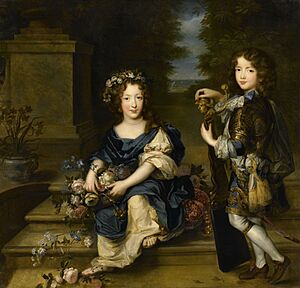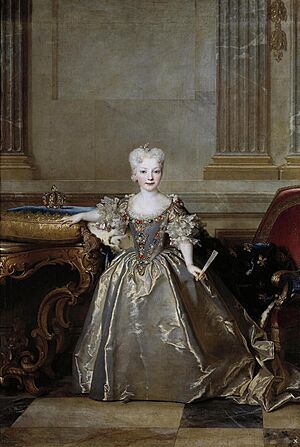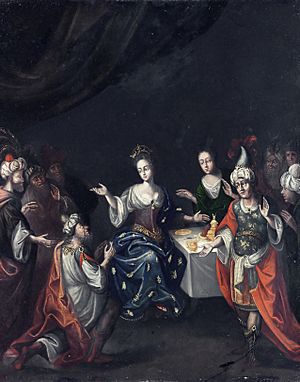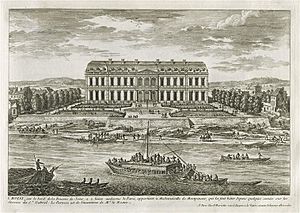Marie Anne de Bourbon facts for kids
Quick facts for kids
Marie-Anne de Bourbon
|
|
|---|---|
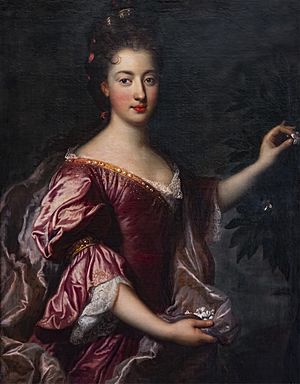
|
|
| Born |
Marie-Anne de La Blaume Le Blanc de La Vallière
2 October 1666 Castle of Vincennes, Vincennes, Kingdom of France
|
| Died | May 3, 1739 (aged 72) Paris, Kingdom of France
|
| Burial place | Saint-Roch, Paris |
| Known for | Illegitimate child of Louis XIV |
| Title | Légitimée de France Mademoiselle de Blois (1667–1680) Princess of Conti (1680–1739) Duchess of La Vallière and of Vaujours (1710–1739) |
| Spouse(s) | Louis Armand I, Prince of Conti |
| Parent(s) | Louis XIV Louise de La Vallière |
| Family | House of Bourbon (by birth and by marriage) House of Bourbon-Conti (by marriage) |
| Signature | |
Marie Anne de Bourbon was a French noblewoman. She was the oldest daughter of Louis XIV, the King of France, and his mistress Louise de La Vallière. She was also the king's favorite daughter.
Marie Anne was born on October 2, 1666. She was officially recognized by the king in 1667. This meant she could use the royal family name "de Bourbon." She was given the title Mademoiselle de Blois.
In 1680, she married Louis Armand I, Prince of Conti. She became the Princess of Conti. Sadly, her husband died in 1685. Marie Anne never married again and did not have any children. When her mother died in 1710, Marie Anne inherited her titles, becoming the Duchess of La Vallière and Vaujours.
Contents
Early Life of Marie Anne
Marie Anne was born in secret at the Castle of Vincennes on October 2, 1666. Her mother was Louise de La Vallière, who was the mistress of King Louis XIV. Marie Anne had several older brothers, but they all died very young.
On May 14, 1667, King Louis XIV officially recognized Marie Anne as his daughter. This made her a "legitimized" child, meaning she was accepted into the royal family even though her parents were not married. After this, she was known as Mademoiselle de Blois.
On the same day, her mother, Louise, was given the titles of Duchess of La Vallière and Vaujours. This was a sign that her relationship with the king was ending. Marie Anne's younger brother, Louis, was born later that year. Both Marie Anne and Louis were cared for by Madame Colbert, whose husband was a very important minister to the king.
Married Life as Princess of Conti
On January 16, 1680, when Marie Anne was 13 years old, she married her distant cousin, Louis-Armand I de Bourbon. He was 18 and known as the Prince of Conti. Their wedding took place at the Castle of Saint-Germain-en-Laye.
This marriage caused some talk because Louis-Armand was a "Prince of the Blood." This meant he was a direct, legitimate descendant of a king. Marie Anne, however, was a legitimised child, not born within a marriage. King Louis XIV often arranged for his legitimised daughters to marry into important royal families.
Even though the prince fell in love with Marie Anne right away, their marriage was difficult. They did not have any children during their five years together.
For about four years after her marriage, Marie Anne was one of the most important ladies at her father's court. Only the Queen and a few other high-ranking princesses were above her.
However, in May 1685, her younger half-sister, Louise-Françoise, married the Duke of Bourbon. The Duke of Bourbon's family was more senior than the Conti family. This meant Louise-Françoise now outranked Marie Anne. This caused some tension between the two sisters.
In 1685, Marie Anne caught smallpox, a serious disease. Her husband also caught it from her. Marie Anne recovered, but her husband died five days later. After his death, she was known as Madame la Princesse Douairière de Conti, which means "Madam the Dowager Princess of Conti." She was also called "the Great Princess of Conti."
Life as a Widow
The issue of who ranked higher was always very important to Marie Anne. In February 1692, her half-sister Françoise-Marie married Philippe, Duke of Chartres. Françoise-Marie was given a very large dowry and outranked both Marie Anne and her other sister, Louise-Françoise. Françoise-Marie often showed off her higher rank, which made her sisters dislike her.
After King Louis XIV died in 1715, his four-year-old grandson became king. A "regency" was set up, meaning someone else ruled the country until the king was old enough. Marie Anne's brother-in-law, Philippe, Duke of Orléans, became the regent.
In 1721, Marie Anne was put in charge of teaching the young Infanta Mariana Victoria of Spain. The Infanta was three years old and was supposed to marry the new King Louis XV. However, the engagement was called off four years later. The king needed an heir to the throne, and the Infanta was too young to marry and have children yet. She was sent back to Spain in 1725. After this, Marie Anne mostly retired from court life and spent her time in the countryside.
Marriage Offers
Marie Anne was known for her beauty. In 1698, when she was 32, she might have received a marriage proposal from her 15-year-old nephew, Philippe, Duke of Anjou. He later became the King of Spain. She also turned down a proposal from the Sultan of Morocco, Ismail Ibn Sharif. She preferred to remain free as a widow.
The Three Princesses of Conti
In 1709, the next Prince of Conti, François-Louis, died. This meant there was now a second dowager princess of Conti. To tell them apart, Marie Anne was called "Madam the Princess of Conti First Dowager."
In 1713, Marie Anne helped arrange the marriage of her late husband's nephew, Louis-Armand II, Prince of Conti. He married her half-niece, Louise Élisabeth de Bourbon. When Louis-Armand II died in 1727, Louise Élisabeth became the "Madam the Princess of Conti Third Dowager."
Homes and Wealth
In 1710, Marie Anne's mother died. Her mother had lived as a nun in a Paris convent. She left Marie Anne a large fortune that she had gained as the king's mistress. Marie Anne also inherited her mother's titles, becoming the Duchess of La Vallière and Vaujours.
In 1713, Marie Anne bought a grand house in Paris called the Hôtel de Lorges. She lived there from 1715. In 1716, she also bought the Castle of Choisy. In 1718, King Louis XV gave her the Castle of Champs-sur-Marne. She later gave this castle to her nephew to help pay off some debts.
Family Relationships
Marie Anne had a very good relationship with her father, King Louis XIV. She was his favorite daughter. She was also close to her only full brother, Louis, Count of Vermandois. His death at age 16 in 1683 made her very sad.
However, she had a difficult relationship with her half-sisters, Louise-Françoise and Françoise-Marie. This was mainly because they outranked her after their marriages.
Marie Anne had a close relationship with her only legitimate half-brother, Louis, the Grand Dauphin. She often visited him at his country home, the Castle of Meudon. There, she met a young, poor nobleman named the Knight of Clermont-Chaste. She fell in love with him. The king found out about their romance and sent the knight away.
Marie Anne did not seem to like the Grand Dauphin's first wife, Maria Anna of Bavaria. Once, when she saw Maria Anna sleeping, Marie Anne said she was "as ugly asleep as she was awake." Maria Anna woke up and replied that she did not "have the advantage of being a love child." After Maria Anna's death in 1690, the Grand Dauphin secretly married Marie Anne's maid of honor. Marie Anne was very sad when her half-brother died in 1711.
Marie Anne de Bourbon died in Paris on May 3, 1739, from a brain tumor. She was buried in the Saint-Roch Church in Paris. Her titles and fortune were passed on to her nephew, Charles-François de La Baume Le Blanc, and then to his son.
Titles and Styles
- October 2, 1666 – May 14, 1667: Mademoiselle Marie-Anne de La Blaume Le Blanc de La Valliére
- May 14, 1667 – January 16, 1680: Mademoiselle de Blois
- January 16, 1680 – May 3, 1739: Madame la Princesse de Conti
- November 9, 1685 – May 3, 1739: Madame la Princesse Douairière de Conti
- February 22, 1709 – May 3, 1739: Madame la Princesse de Conti Première Douairière
- November 9, 1685 – May 3, 1739: Madame la Princesse Douairière de Conti
See also
 In Spanish: María Ana de Borbón para niños
In Spanish: María Ana de Borbón para niños


